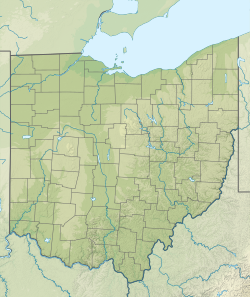
Back Columbus, Ohio Afrikaans ኮለምበስ፣ ኦሃዮ Amharic Columbus (Ohio) AN Columbus (Ohio) ANG كولومبوس (أوهايو) Arabic كولومبوس (اوهايو) ARZ Columbus (Ohio) AST Kolumbus (Ohayo) Azerbaijani کولمبوس AZB Kolumbs BAT-SMG
Columbus | |
|---|---|
|
| |
 Interactive map of Columbus | |
| Coordinates: 39°57′44″N 83°00′02″W / 39.96222°N 83.00056°W | |
| Country | United States |
| State | Ohio |
| Counties | |
| Settled | February 14, 1812 |
| Incorporated | February 10, 1816[1] |
| Named after | Christopher Columbus |
| Government | |
| • Type | Mayor–council |
| • Body | Columbus City Council |
| • Mayor | Andrew Ginther (D) |
| • Council members | List[2] |
| Area | |
| 226.26 sq mi (586.00 km2) | |
| • Land | 220.40 sq mi (570.82 km2) |
| • Water | 5.86 sq mi (15.18 km2) |
| Elevation | 791 ft (241 m) |
| Population (2020) | |
| 905,748 | |
• Estimate (2024)[5] | 933,263 |
| • Rank | 40th in North America 14th in the United States 1st in Ohio |
| • Density | 4,109.64/sq mi (1,586.74/km2) |
| • Urban | 1,567,254 (US: 35th) |
| • Urban density | 3,036.4/sq mi (1,172.3/km2) |
| • Metro | 2,138,926 (US: 32nd) |
| Demonym | Columbusite[7] |
| GDP | |
| • Metro | $182.088 billion (2023) |
| Time zone | UTC−5 (EST) |
| • Summer (DST) | UTC−4 (EDT) |
| ZIP Codes | ZIP Codes[9] |
| Area codes | 614 and 380 |
| FIPS code | 39-18000 |
| GNIS feature ID | 1086101[4] |
| Website | www |
Columbus (/kəˈlʌmbəs/, kə-LUM-bəs) is the capital and most populous city of the U.S. state of Ohio. With a 2020 census population of 905,748,[5] it is the 14th-most populous city in the U.S., the second-most populous city in the Midwest (after Chicago), and the third-most populous U.S. state capital (after Phoenix, Arizona, and Austin, Texas). Columbus is the county seat of Franklin County; it also extends into Delaware and Fairfield counties.[10] The Columbus metropolitan area encompasses ten counties in central Ohio and had a population of 2.14 million in 2020, making it the largest metropolitan area entirely in Ohio[a] and 32nd-largest metro area in the U.S.
Columbus originated as several Native American settlements along the Scioto River. Franklinton, now a city neighborhood, became the first European settlement in 1797. The city was founded in 1812 at the confluence of the Scioto and Olentangy rivers and was planned as the state capital. Named after Italian explorer Christopher Columbus, it assumed the role of capital in 1816 and became the county seat in 1824. Despite periods of flooding and economic downturns, the city grew steadily through industrialization. Beginning in the 1950s, Columbus experienced rapid expansion, becoming Ohio's largest city by land and population by the early 1990s. Growth has continued into the 21st century, with major redevelopment in neighborhoods across the city, including downtown.
Columbus has a diverse economy. The metropolitan area is home to the Battelle Memorial Institute, the world's largest private research and development foundation; Chemical Abstracts Service, the world's largest clearinghouse of chemical information; and the Ohio State University, one of the largest universities in the United States. The Greater Columbus area is further home to the headquarters of Fortune 500 companies Cardinal Health, Nationwide, American Electric Power, Huntington Bancshares and Vertiv. It hosts cultural institutions such as the Columbus Museum of Art, COSI, Franklin Park Conservatory and Ohio Theatre. The city's major league professional sports teams include the Columbus Blue Jackets (NHL) and Columbus Crew (MLS).
- ^ Cite error: The named reference
Manualwas invoked but never defined (see the help page). - ^ "City Council: Staff Directory". City of Columbus. Retrieved July 28, 2024.
- ^ "ArcGIS REST Services Directory". United States Census Bureau. Archived from the original on January 19, 2022. Retrieved September 20, 2022.
- ^ a b U.S. Geological Survey Geographic Names Information System: Columbus, Ohio
- ^ a b "Columbus city, Ohio". QuickFacts. United States Census Bureau. Retrieved May 15, 2025.
- ^ "2020 Population and Housing State Data". United States Census Bureau. Archived from the original on August 12, 2021. Retrieved August 22, 2021.
- ^ "Things you'll never hear a Columbusite say". News Radio 610 WTVN. April 25, 2014. Archived from the original on October 31, 2014.
- ^ "Total Gross Domestic Product for Columbus, OH (MSA)". www.bea.gov.
- ^ "Zip Code Lookup". USPS. Archived from the original on September 3, 2007. Retrieved November 15, 2014.
- ^ "Places in Franklin County, OH". Find a County. National Association of Counties. Archived from the original on June 16, 2008. Retrieved April 13, 2010.
- ^ "Metropolitan and Micropolitan Statistical Areas Population Totals and Components of Change: 2010–2019". United States Census Bureau, Population Division. April 2019. Archived from the original on June 16, 2020. Retrieved April 18, 2020.
Cite error: There are <ref group=lower-alpha> tags or {{efn}} templates on this page, but the references will not show without a {{reflist|group=lower-alpha}} template or {{notelist}} template (see the help page).
© MMXXIII Rich X Search. We shall prevail. All rights reserved. Rich X Search








